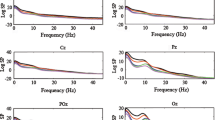Abstract
Spectral analysis (spectral density histograms) of neuron spike activity in the hippocampus of rabbits of different ages revealed trace assimilation of rhythms – an analog of a conditioned reflex to time – after rhythmic stimulation. An association was established between the number of series of periodic electrocutaneous stimulation presented and the extent of trace assimilation of the rhythm, depending on the age of the animal. Trace assimilation of rhythms occurred more slowly in older animals (aged 54–65 months) than in young animals (aged up to one year), predominantly on days 2–3 of experiments after presentation of 2–4 series of rhythmic stimulation, and persisted in a small proportion of cases on the day following stimulation. Periodic stimulation in very old animals (aged 66–85 months) almost completely failed to induce plastic rearrangements of hippocampal neuron activity. Stimulation produced a non-specific trace increase in the frequency of hippocampal baseline neuron activity in old animals. Quantitative and qualitative morphological changes were identified in the nerve and glial cells of the hippocampus of aged rabbits, as compared to young rabbits. It is suggested that the change in the course of mnestic processes seen in animals with aging may be associated with age-related destructive changes in the hippocampus.
Similar content being viewed by others
REFERENCES
N. N. Bogolepov, Brain Ultrastructure in Hypoxia [in Russian], Meditsina, Moscow (1979).
O. S. Vinogradova, “Current concepts of the general characteristics and plastic features of hippocampal neurons,” Usp. Fiziol. Nauk., 15, No. 1, 28–54 (1984).
L. L. Voronin, “Some statistical features of the spontaneous and evoked activity of cortical neurons,” in: Statistical Electrophysiology, E. Narushevichus (ed.), Vilnius Medical Institute, Vilnius (1968), Part 1, pp. 100–114.
L. L. Voronin, Analysis of Plastic Properties in the Central Nervous System [in Russian], Metsniereba, Tbilisi (1982).
V. N. Kleshchinov and V. N. Vostrikov, “Electron-cytochemical characteristics of hyperchromic neurons in schizophrenia,” Zh. Nevropatol. Psikhiatr. S. S. Korsakova, 85, No. 7, 989–992 (1985).
F. V. Kopytova, “Tracing rhythm assimilation by neurons in the sensorimotor cortex of aged rabbits,” Zh. Vyssh. Nerv. Deyat., 42, No. 2, 341–350 (1992).
F. V. Kopytova, L. M. Gershtein, and M. T. Dobrynina, “Morphochemical features and plastic rearrangements of hippocampal neurons after rhythmic stimulation of the limb in aged rabbits,” Zh. Vyssh. Nerv. Deyat., 49, No. 1, 123–126 (1999).
F. V. Kopytova, G. N. Krivitskaya, and Yu. S. Mednikova, “Morphofunctional characteristics of neurons in the sensorimotor cortex of aged rabbits in conditions of tracing rhythm assimilation,” Zh. Vyssh. Nerv. Deyat., 42, No. 4, 710–719 (1992).
“The limbic system and the hypothalamus,” in: Aging of the Brain [in Russian], V. V. Frol'kis (ed.), Nauka, Leningrad (1991), Chapter 8, pp. 148–152.
V. N. Mats and O. L. Segal, “Topographical changes in protein metabolism of neurons in the rat motor cortex and hippocampus during acquisition of a conditioned reflex in normal conditions and with treatment with a cyclic enkephalin analog,” in: The Neurochemical Bases of Learning and Memory [in Russian], Nauka, Moscow (1989), pp. 135–155.
V. N. Mats, Neuron-Glial Relationships in the Neocortex in Learning [in Russian], Nauka, Moscow (1994).
T. A. Mering, “Structural bases of the temporal support of nervous activity,” Usp. Fiziol. Nauk., 21, No. 4, 103–122 (1990).
D. D. Orlovskaya and V. N. Kleshchinov, “The neuron and the hyperchromic state,” Zh. Nevropatol. Psikhiatr. S. S. Korsakova, 86, No. 7, 981–988 (1986).
É. N. Popova, S. K. Lapin, and G. N. Krivitskaya, Morphology of Adaptive Changes in Neural Structures [in Russian], Meditsina, Moscow (1976).
É. N. Popova, L. B. Verbitskaya, and L. A. Kukuev, “Morphological changes in human and animal brain structure in ageing (comparative studies),” Zh. Nevropatol. Psikhiatr. S. S. Korsakova, 86, No. 12, 1860–1868 (1986).
T. B. Shvets-Ténéta-Gurii, G. I. Troshin, A. G. Dubinina, and M. R. Novikova, “Oscillations in the redox state potential of brain tissue developing in rats in the states of waking and slow sleep,” Zh. Vyssh. Nerv. Deyat., 50, No. 2, 261–273 (2000).
L. F. Agnati, M. Zoli, G. Biagini, and K. Fuxe, “Neuronal plasticity and ageing processes in the frame of the 'Red Queen Theory,'” Acta Physiol. Scand., 145, No. 4, 301–309 (1992).
J. T. Coyle, D. L. Price, and M. R. DeLong, “Alzheimer's disease: a disorder of cortical cholinergic innervation,” Science, 219, No. 4589, 1184–1190 (1983).
L. Einerson and E. J. Krogh, “Variation in the basophilia of nerve cells associated with increased cell activity and functional stress,” Neurol. Neurosurg. Psychiatry, 18, No. 1, 1–12 (1955).
G. Horn, P. Bradley, and B. I. McCabe, “Changes in the structure of synapses associated with learning,” J. Neurosci., 5, No. 12, 3161–3168 (1985).
M. D. McEchron, A. P. Weible, and J. F. Disterhoft, “Aging and learning-specific changes in single-neuron activity in CA1 hippocampus during rabbit trace eyeblink conditioning,” J. Neurophysiol., 86, No. 4, 1839–1857 (2000).
H. Olita, H. Nishikawa, K. Hirai, et al., “Relationship of impaired brain glucose metabolism to learning deficit in the senescence-accelerated mouse,” Neurosci. Lett., 217, No. 1, 37–40 (1996).
M. E. Scheibel, R. D. Lindsay, V. Tomiyasu, and A. B. Scheibel, “Progressive dendritic changes in aging human cortex,” Exptl. Neurol., 47, No. 3, 392–403 (1975).
J. Shen, C. A. Barnes, B. L. McNaughton, et al., “The effect of aging on experience-dependent plasticity of hippocampal place cells,” J. Neurosci., 17, 6769–6782 (1997).
L. L. Voronin, “Microelectrode study of neurophysiological mechanisms of conditioning,” in: Soviet Research Reports. Brain Information Service. C. D. Woody (Ed.), Brain Research Institute, UCLA, Los Angeles (1976), Vol. 2.
M. N. Zadin, “On normalization of the crosscorrelation function of pulse activity,” Studia Biophysica, 128, No. 2, 95–103 (1988).
Rights and permissions
About this article
Cite this article
Kopytova, F.V., Mednikova, Y.S. & Popova, É.N. Age-Related Structural and Functional Characteristics of Rabbit Hippocampal Neurons During the Formation of Temporal Associations. Neurosci Behav Physiol 34, 889–896 (2004). https://doi.org/10.1023/B:NEAB.0000042573.05342.95
Issue Date:
DOI: https://doi.org/10.1023/B:NEAB.0000042573.05342.95



